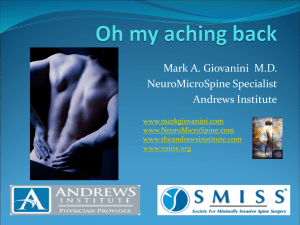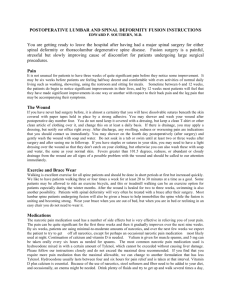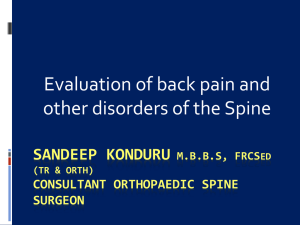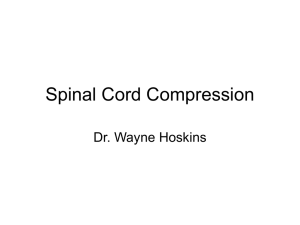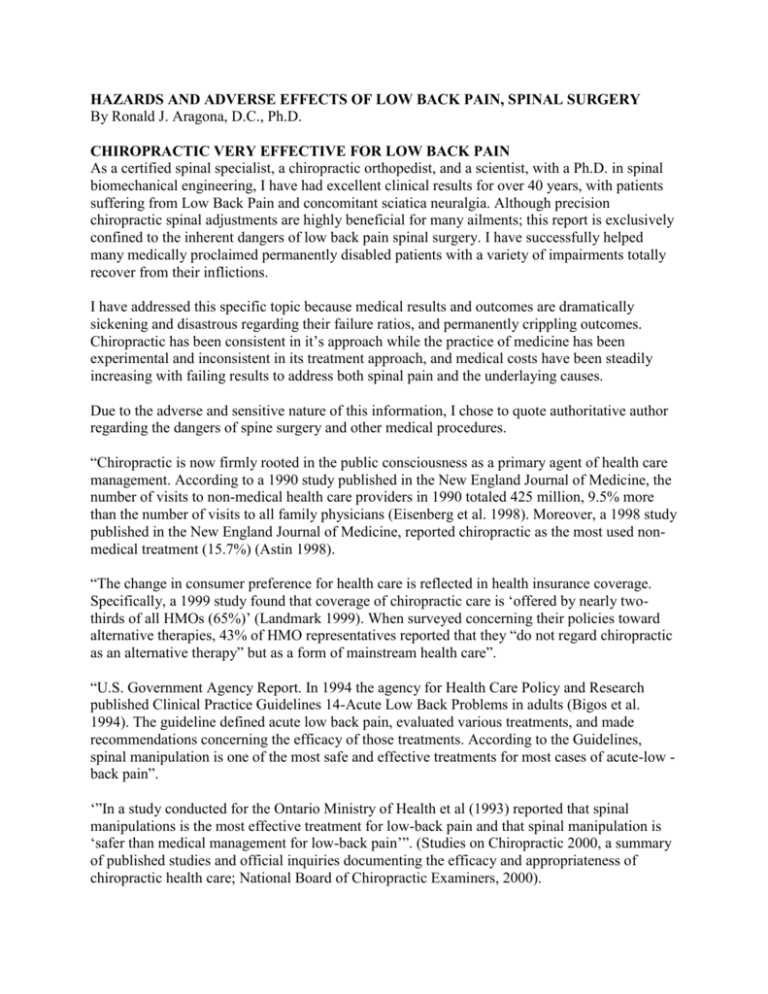
HAZARDS AND ADVERSE EFFECTS OF LOW BACK PAIN, SPINAL SURGERY
By Ronald J. Aragona, D.C., Ph.D.
CHIROPRACTIC VERY EFFECTIVE FOR LOW BACK PAIN
As a certified spinal specialist, a chiropractic orthopedist, and a scientist, with a Ph.D. in spinal
biomechanical engineering, I have had excellent clinical results for over 40 years, with patients
suffering from Low Back Pain and concomitant sciatica neuralgia. Although precision
chiropractic spinal adjustments are highly beneficial for many ailments; this report is exclusively
confined to the inherent dangers of low back pain spinal surgery. I have successfully helped
many medically proclaimed permanently disabled patients with a variety of impairments totally
recover from their inflictions.
I have addressed this specific topic because medical results and outcomes are dramatically
sickening and disastrous regarding their failure ratios, and permanently crippling outcomes.
Chiropractic has been consistent in it’s approach while the practice of medicine has been
experimental and inconsistent in its treatment approach, and medical costs have been steadily
increasing with failing results to address both spinal pain and the underlaying causes.
Due to the adverse and sensitive nature of this information, I chose to quote authoritative author
regarding the dangers of spine surgery and other medical procedures.
“Chiropractic is now firmly rooted in the public consciousness as a primary agent of health care
management. According to a 1990 study published in the New England Journal of Medicine, the
number of visits to non-medical health care providers in 1990 totaled 425 million, 9.5% more
than the number of visits to all family physicians (Eisenberg et al. 1998). Moreover, a 1998 study
published in the New England Journal of Medicine, reported chiropractic as the most used nonmedical treatment (15.7%) (Astin 1998).
“The change in consumer preference for health care is reflected in health insurance coverage.
Specifically, a 1999 study found that coverage of chiropractic care is ‘offered by nearly twothirds of all HMOs (65%)’ (Landmark 1999). When surveyed concerning their policies toward
alternative therapies, 43% of HMO representatives reported that they “do not regard chiropractic
as an alternative therapy” but as a form of mainstream health care”.
“U.S. Government Agency Report. In 1994 the agency for Health Care Policy and Research
published Clinical Practice Guidelines 14-Acute Low Back Problems in adults (Bigos et al.
1994). The guideline defined acute low back pain, evaluated various treatments, and made
recommendations concerning the efficacy of those treatments. According to the Guidelines,
spinal manipulation is one of the most safe and effective treatments for most cases of acute-low back pain”.
‘”In a study conducted for the Ontario Ministry of Health et al (1993) reported that spinal
manipulations is the most effective treatment for low-back pain and that spinal manipulation is
‘safer than medical management for low-back pain’”. (Studies on Chiropractic 2000, a summary
of published studies and official inquiries documenting the efficacy and appropriateness of
chiropractic health care; National Board of Chiropractic Examiners, 2000).
Acute low-back pain is less than three months; chronic low-back pain is more than three months.
“Van Tulder, Koes and Bowter (1997), researchers in the Netherlands funded by the Dutch
Health Insurance Board, retrieved and evaluated evidence from 48 randomized controlled trials
conducted worldwide that addressed the treatment of acute and chronic low-back pain.
Researchers found ‘strong evidence’ for the effectiveness of spinal manipulation in the treatment
of chronic low-back pain (National Board)”.
ABC NEWS
http://abcnews.go.com/print?id=4288079
The following verbatim quotation proves both the ineffectiveness and outrageous costs of medical
procedures for back pain.
“U.S. back pain costs rise but pain still there
By Julie Steenhuysen
Reuters
Chicago
“The total cost of treating back pain in the United States has risen 65 percent in the past decade,
but after all the pricey treatments, many people are still left with an aching back and an
increasingly empty wallet, U.S. researchers said on Tuesday.
“They said treating spine problems in the United States costs $85.9 billion a year, rivaling the
economic burden of treating cancer, which costs $89 billion.
“Higher spending on prescription drugs, more advanced diagnostic tests and more frequent
outpatient visits helped drive the increases, as well as greater patient demand for treatment and
more use of spinal fusion surgery and instruments, they said.
“Yet, for all of the spending, they found people with spine problems actually felt worse.
“‘Health care expenditures for people with spinal problems have increased substantially -- 65
percent since 1997. Within that, we found pharmaceutical expenditures have increased 171
percent,’ said Brook Martin of the University of Washington in Seattle, whose study appears in
the Journal of the American Medical Association.
"’If we are spending that much money on spine problems, we would expect to see improvements
in the health of the population,’ Martin said in a telephone interview.
"’What this study shows is we are not seeing commensurate improvements among people with
spine problems.’
“Martin and colleagues analyzed data from 1997 to 2005 from a nationally representative survey
of patient health expenditures and health status.
“They found that people with spine problems on average spent $4,695 per year in 1997 in
inflation adjusted dollars on health costs, compared with the average $2,731 spent for people
without back problems.
“The average health cost for spine patients in 2005 rose to $6,096, compared with $3,516 for
people without those problems.
“MORE REPORT LIMITATIONS
“The proportion of spine patients reporting physical, social and work limitations rose to 24.7
percent in 2005 from 20.7 percent in 1997
"’What we're seeing is that although costs have gone up, outcomes have not changed, which is
really discouraging," said Dr. Orly Avitzur, a neurologist from Tarrytown, New York, and an
adviser to Consumer Reports, which recently named back surgery on its top 10 list of ‘Medical
Gotchas.'
“The research follows a number of recent studies showing that some patients who skip surgery
for back pain fare just as well over time as those who have the surgery.
"’It's best to be conservative and take a wait-and-see approach, especially in the initial stages of
low back pain,’ Avitzur said in a telephone interview.
“Dr. Paul Rubery, a spine surgeon at the University of Rochester Medical Center in New York,
noted that higher drug spending and increased use of diagnostic tests such as magnetic resonance
imaging accounted for a lot of the increased costs.
“He said the study emphasizes the need for use of treatments with proven benefits.
“Dr. Richard Fessler, a professor of neurosurgery at Northwestern University in Chicago,
challenged the study's findings and methodology. "I think their conclusions are unwarranted and
very misleading," he said.
“Fessler, in an e-mail, said the study fails to mention several large recent clinical trials that
showed certain patients undergoing spinal surgery improved significantly.
“Martin said his work is not an indictment of anyone approach to treating back pain. ‘This study
is a broad view of trends overall,’ he said.
"’Really, the goal should be to match the right treatment to the right patient who will benefit
from it. I think that is sometimes where we fall short.’”
Copyright 2008 Reuters News Service. All rights reserved. This material may not be published,
broadcast, rewritten, or redistributed.
Copyright © 2008 ABC News Internet Ventures
CHIROPRACTIC MORE EFFECTIVE FOR LOW BACK INJURIES
Acute low-back pain is less than three months; chronic low-back pain is more than three months.
“Van Tulder, Koes and Bowter (1997), researchers in the Netherlands funded by the Dutch
Health Insurance Board, retrieved and evaluated evidence from 48 randomized controlled trials
conducted worldwide that addressed the treatment of acute and chronic low-back pain.
Researchers found ‘ strong evidence’ for the effectiveness of spinal manipulation in the
treatment of chronic low-back pain (National Board)”.
“A 1998 study of 10,652 Florida workers’ compensation cases was conducted by Wolk and
reported by the Foundation for Chiropractic Education and Research. According to Wolk, back
injury patients treated by chiropractors vs. medical doctors or osteopaths were less likely to
develop compensable injuries (injuries resulting in time loss from work and therefore requiring
compensation) and less likely to require hospitalization. The Author explained that chiropractors
are more effective in treating low-back injuries because ‘Chiropractic treatment, in providing
more services to the patient at the outset of injury, may produce more immediate therapeutic
results and may reduce the amount of time lost from work’”, (National Board of Chiropractic
Examiners).
In the same geometrical area, if there are 10 surgeons, 10 times the number of spinal surgeries
was performed, as an exclusive financial endeavor.
‘“Failed Back Surgery’, Back surgery for herniation should only be attempted as a last resort.
That is because back surgery is a dangerous procedure with a high failure rate. The failure of
back surgery is so common that those suffering from it have Failed Back Surgery Syndrome.
About 600,000 back surgeries are performed per year with an average failure of 53%. “‘(Koren
Publishers, Inc.).
Back Pain: no to steroids
01 January1992
WDDTY Health Shop
www.wddty.com
WDDTY is a monthly journal- described as the best in the world- it’s a research database, and it’s a portal for you to share your
health experiences.
“The latest fad for chronic low back pain namely injecting steroids into the facet joints has just
been proved useless.
“Researchers writing in the New England Journal of Medicine conducting fastidious and long
term follow up of patients injected with steroid treatment found, in the words of an
accompanying editorial, that the treatment was ‘overused and minimally effective’.
“The editorial said that this latest treatment follows a long history of faddish treatments for this
problem fusing the sacroiliac, removing the coccyx, electrical nerve stimulation which all in time
have been abandoned.
“To avoid more faddish approaches, the editorial called for practice to be ‘based more firmly on
the results of rigorous outcomes research, and less on seductive theories’.
“The author, Dr Richard Deyo of the Veterans Affairs Medical Center in Seattle, Washington,
also says that in too many cases investigators have vested interests in favorable results. ‘Too
much research on back problems consists of case series that serve the entrepreneurial purpose of
legitimizing expensive new forms of technology, rehabilitation centers or surgical programs of
uncertain effectiveness’, he writes”.
A CRAZY NEW MEDICAL BACK PAIN TREND: BURN THE NERVES
In my opinion, this is one of the most insane new medical approach to reduce back pain; burn off
the free nerve endings which elicit pain; thus reducing or eliminating back pain. People who
want a quick fix or instant gratification will go for this new medical fad. They don’t understand
that the cause of their spinal pain is frequently misalignment, subluxated vertebrae evoking
pressure on their nerves. Is there a quick fix for crooked teeth, cancer, heart disease, tooth decay,
etc.? What makes people think there is a quick fix for distorted painful spinal deformities? There
is no quick fix. It takes specific chiropractic treatment compliance, sacrifice, and many other
factors to save your spinal health. Quick fix people will rush for this insane medical procedure
until it, like most other medical spinal faddish procedures are proven useless and dangerous; thus
eventually legally discontinued.
Pain is a warning that something is seriously wrong. It’s like a big red flag saying, “Stop, don’t
lift that, don’t bend that way, etc.” The absence of pain does not mean, all is “OK”; most people
with brain cancer don’t have pain! Therefore, if you have back pain, you probably have a serious
misalignment, subluxation problem and if you don’t have back pain you can be developing a
serious problem; with the passing of time the magnitude can become protractivelly worse.
Burning the free nerve endings is only a temporary procedure and has to be repeated. It is not
effective for disc and other serious spinal problems which chiropractic care usually helps.
The following is a verbatim quote from www.ThirdAge.com Health and Wellness
“ZAP! BACK PAIN GETS BURNED”
“Doing her dishes and making the bed cause Marian Madonna to positively wince. Walking
through the grocery store entails gingerly hanging onto a cart.
“Getting out of a car? Whew. Going up and down steps? Horrible.
“The 74-year-old Millersville, Pa., woman has arthritis in her back, which has triggered
excruciating back pain.
“She has tried medication but it doesn't work. She has tried steroid injections, but they worked
for only two days.
“Recently, she tried a treatment that consists of burning the problem nerves in her back. It can be
used to treat certain types of back and neck pain, and headaches.
“During an outpatient procedure at the Surgery Center of Lancaster, Pa., Dr. David Simons, a
local anesthesiologist, placed a needle into Madonna's back, inserted an electrode into the needle
and zapped the nerves that were causing her problems.
“Madonna was awake for part of the procedure, where Simons did some testing to ensure he was
finding the right nerves, and lightly sedated while he did the actual burning.
"’I did the dishes last night and it didn't hurt as bad,’ she said recently. ‘I thought, This is great.'
“Simons told her it could take a little while for her to feel the full effect of the treatment.
It annihilates the nerve, he told her. After about two weeks, this thing should feel really good.
“Called radiofrequency ablation, the treatment recently has been updated to allow physicians to
treat up to four spots simultaneously, for quicker treatments.
“The treatment, which is not designed for disc pain, generally lasts from nine months to
two years. After that, nerves may grow back and need subsequent treatment.
“The treatment is helpful for patients like Madonna, who would not be a good candidate
for surgery due to the nature of her back problem, Simons said.
“This allows us to take care of patients we wouldn’t have been able to t ake care of in the
past, he said.”
“Back pain: the dangers of surgery - At the first sign of back pain ...
WDDTY Health Shop
“If you have low back pain, instead of rushing to your own doctor, first try the most conservative
management you can. Dr William Kirkaldy-Willis, retired emeritus professor of the Department
of Orthopaedic Surgery at the University of Saskatchewan College of Medicine in Canada and a
world-renown advocate of conservative management, believes that back pain can only be sorted
out with a multi disciplined approach and that conservative management can help many of those
with problems formerly thought to be the province of the surgeon. In Kirkaldy's view, only about
5-10 per cent of patients with disc herniations require surgery.
“* Consider working with a fully trained and qualified, experienced chiropractor, osteopath or
physiotherapist first. The Manga Report (August 1993), put together by Professor Pran Manga,
former director-general of the Health and Social Policy Directorate of the Canadian government,
analyzed the published evidence worldwide. His conclusion: 'Spinal manipulation applied by
chiropractors is shown to be more effective than alternative treatments for lower back pain.' One
such study (The Lancet, 28 July 1990) showed a seven-point advantage of chiropractic treatment
over conventional hospital management on a Oswestry disability index.
“* Don't consent to a myelogram under any but the most desperate circumstances and only after
you've had a second expert opinion. MRI and CT scanning have largely replaced myelograms for
all but certain specific conditions.
“* Surgery will potentially help only disc herniation, instability, stenosis, spondylolisthesis, and
scoliosis. If you don't have a definitive diagnosis of any of the above, don't consent to be put
under the knife.
“* Find an orthopedic specialist in sympathy with the teachings of Kirkaldy-Willis. If you can
afford it, get hold of Managing Low Back Pain by Kirkaldy-Willis and Burton (Churchill
Livingstone, Edinburgh and New York), which will help to put you on an equal footing with
your orthopedic specialist.
“* Find a 'back school' which will educate you about the cause of your pain, good daily low back
care and an early return to full functioning.
“* Contact grass-roots organizations like the Action Group for Relief of Pain and Distress in the
UK (Hills View, Aller Road, Dolton, Winkleigh, Devon EX19 80P). (For information on selfmanipulation, send £2.50 for their book 'A Safety Net'.)”
WDDTY Health Shop
“Back pain: the dangers of surgery - More westerners than ever suffer from low back pain,
but conventional treatments -surgery, injections, anaesthesia - often make the problem
worse.
“At some point in our lives, 80 per cent of us living in the West will suffer from disabling low
back pain. Every year, 12 million Americans make new-patient visits to their doctor for chronic
low back problems and 100 million patient visits are made to chiropractors. Indeed, more work
days are lost from low back pain than any other form of disability in the US and the UK alone,
and the number of working days lost has doubled every decade, currently standing, at 60 million
in the UK. This places back pain squarely in the number one slot as the most common cause of
disability after cardiovascular disease.
“Low back pain has been called the 'Cinderella' of medicine and with good cause. In most cases,
medicine itself practice has shown a shocking ineptitude in diagnosing and treating back
problems, often making the problem worse. This terrible batting average has led a Canadian
government report, which studied the available evidence to date, to conclude: 'Many medical
therapies are of questionable validity or are clearly inadequate,'
“In a scathing article published in 1990 by the International Society for the Study of the Lumbar
Spine, Professor Gordon Waddell, orthopaedic surgeon at Glasgow's Western Infirmary summed
up this appalling track record: "...dramatic surgical successes, unfortunately, apply to only some
1 per cent of patients with low back disorders. Our failure is in the remaining 99 per cent of
patients with simple backache, for whom, despite new investigations and all our treatments, the
problem has become progressively worse.' (The Lumbar Spine, James Weinstein and Sam
Wiesel, eds., WB Saunders Co, Philadelphia, 1990.)
“For back patients who undergo surgery, 15 to 20 per cent will fall into the category of 'the failed
back' - the official nomenclature for people with chronic, considerable back pain that doctors
can't fix, Some 200,000 to 400,000 patients go under the knife in the US every year. That
translates into 30,000 people who will emerge from back surgery every year in considerably
more pain than they were before they went to their doctor.
“A special WDDTY review of the current literature about back treatment reveals that medicine
has three ways of making things worse: dangerous diagnostics; inappropriate, unproven
treatment and surgery; and poorly studied regional anaesthesia, often, ironically, used to relieve
the pain.
“In the main, back pain treatments are faddish, adopted in a flurry of enthusiasm and soon
discarded in favor of the next new possibility when evidence proves they don't work.
“An editorial in the New England Journal of Medicine (3 October 1991) says that earlier in this
century, sacroiliac joint disease was believed the culprit in many cases of back pain, leading to
fusions (the joining of one vertebra to another) of sacroiliac joints.
“This was followed by treatments including the removal of the coccyx, injections for herniated
or slipped discs (in which the cushiony centre of the disc, which softens the shock of spinal
movement, protrudes out of the fibrous outside), lengthy bed rest, traction and even
transcutaneous electrical nerve stimulation. The latest fad to be discredited in that same issue of
the journal is steroid injections in the facet joints (the cartilage covering of the bony junction of
two vertebrae), showing that injecting steroids is no better than injecting saline.
“General practitioners, back specialists and orthopaedic surgeons have demonstrated that many
haven't a clue as to what exactly causes most back conditions. In a general review of low back
pain (BMJ, 3 April 1993), Andrew Frank, consultant physician in rheumatology and
rehabilitation at Northwick Park Hospital in Harrow, England, concluded: 'Up to 85 per cent of
patients with low back pain cannot be given a definitive diagnosis because of the poor
associations between symptoms, signs, imaging results and pathological findings.'
“Consequently, many causes of disastrous residual pain are caused by inappropriate surgery. The
most popular operations include: laminectomy, in which a disc and nearby bone are removed to
give the nerve branching off the central spinal cord more space to move without getting trapped
or compressed by the spine; and fusion, in which one vertebrae is surgically joined to another to
minimize what has been diagnosed as too much movement between them. After the operation,
this segment of the spine will be unable to move.
“Henry La Rocca, clinical professor of orthopaedic surgery at Tulane University in New Orleans,
examining six studies of back operations found that removing discs only relieved back pain in
about half of all patients (The Lumbar Spine, as above). He quotes a study in 1980 of 105 cases
of failed spinal surgery, primarily disc removal. In 68 per cent of the patients, they concluded,
surgery wasn't indicated (Spine, 1980; 5: 87-94). Three out of four studies comparing operating
with or without lumbar (lower back) spinal fusion surgery found no advantage for fusion and that
complications, including chronic pain, were common (JAMA, 19 August 1992).
“US orthopaedic surgeon Dr. Charles Burton of the Institute for Low Back Care in Minneapolis,
Minnesota, in analyzing failure of surgery on the spine over 10 years, quotes from a June 1981
interinstitutional orthopaedic and neurosurgical study of 'failed-back surgery syndrome'. In more
than half of all such cases, the diagnosis missed or the surgery itself caused a condition called
'lateral spinal stenosis', or narrowing of a portion of the spine causing compression of the spinal
cord or an abnormally tight fit.
“Finally, postsurgical scarring ('epidural fibrosis') can itself cause failed surgery and chronic
pain. La Rocca also found substantial evidence that surgeons cause nerve root injury as the nerve
is being separated from herniated disc material, causing scarring and therefore long-term pain
and pressure on the nerve. 'Damage to the dura or the cauda equina [membranes covering the
spinal cord] from poor surgical technique yielding possibly catastrophic results completes the
list,' he writes.
“This is precisely what happened to Sarah of Woking. Her back problems developed after a
hysterectomy, so she consented to further surgery on her spine. The delicate layers of the spinal
cord (meninges) became inflamed, and then thickened. This thickened membrane now presses
constantly on her spine, incapacitating her with unbearable pain.
“At Gordon Waddell's clinic in Glasgow in Scotland, '60 per cent believe or have been told that
they have a disc prolapse, although only 11 per cent show any evidence of nerve root
involvement,' he says. Gordon Waddell and others conclude that if there is a specific problem
correctly identified, such as a spinal deformity or fracture or disc herniation, then surgery can
help, but not for simple relief of unspecified back pain (Spine, 1986; 11: 712-19).
“Many hundreds of thousands of cases of chronic, debilitating back pain were - and still are caused by myelograms used purely for diagnosis. This diagnostic tool involves the use a contrast
medium or dye. This is injected into the canal space and trickles into and around all the discs and
nerve roots in the back, which is then x-rayed. Mounting evidence shows that a good percentage
of myelogram patients will develop a condition called arachnoiditis, causing permanent,
unrelenting pain and rendering many virtually unable to move.
“Arachnoiditis is a little-understood condition in which the middle membrane protecting the
spinal cord becomes scarred. Nerves atrophy and become enmeshed in dense scar tissue, which
presses constantly on the spine. Minneapolis' Dr Burton, one of the few medics to make a study
of lumbar sacral adhesive arachnoiditis (LSAA), estimates that it accounts for 11 per cent of
patients with 'failed back surgery syndrome'.
“Although LSAA results from a number of different causes, in Dr Burton's view, it essentially
reflects the introduction of foreign substances into the human subarachnoid space. Dr Burton
says the foreign body most often identified in victims is iophendylate (known as Pantopaque in
the US, Myodil in the UK), the oil-based dye used for myelograms. In LSAA, he says,
iophendylate is often found in a cyst within the scar tissue mass. In his view, a million people
worldwide suffer from arachnoiditis caused by this dye, and this view could be conservative.
Until the 1980s, nearly half a million myelograms were being performed in the US every year.
Pantopaque was introduced in the US in 1944 after one study convinced the medical profession
that it was safe. This was despite animal studies showing that Pantopaque caused arachnoiditis,
says Burton (the Swedes banned the product from use in humans in 1948). Even though the
product is no longer manufactured by Glaxo, since the onset of water-based dyes and imaging
techniques, iophendylate continues to be used around the world, says Burton, and many back
specialists continue to maintain that iophendylate is safe.
“The US Food and Drug Administration and the British government have made no moves to ban
oil-based myelograms. 'Despite the fact that iophendylate was identified as being causally related
to the production of arachnoiditis from the time of its introduction, its use in the US has never
been restricted by industry, government or the medical profession: says Burton.
“It has needed patients with myelogram-induced LSAA to bring legal suits against the
manufacturers before anyone else took notice. In the UK the Arachnoiditis Society now has
some 1000 members and a class-action suit is underway against Glaxo.
“The water-based dyes now being used instead are not without risk. One woman being
investigated for sciatic (back-caused leg) pain with iopamidol (Niopam 200), a water-soluble
contrast medium, was immediately rendered paraplegic (The Lancet 27 July 1991), as was
another middle-aged woman given a myelogram with iohexol (Omnipaque), another watersoluble dye (The Lancet 16 March 1991). Burton says that some new mediums have caused such
pain that they had to be performed under general anaesthesia.
“He concludes: 'The medical profession has not yet succeeded in finding a benign, effective
myelographic medium.'”
Lynne McTaggart
Chiropractic is safer and less expensive for low back pain syndromes. Medical treatment is
radical, highly costly and dangerous. You have a choice. Fix the problem or suffer the
consequences of drugs and surgery. Good Luck with your future health care needs!
Chiropractically Yours,
Dr. Aragona
www.AragonaChiropractic.com
Send this web site to a friend. You will be a friend indeed.



